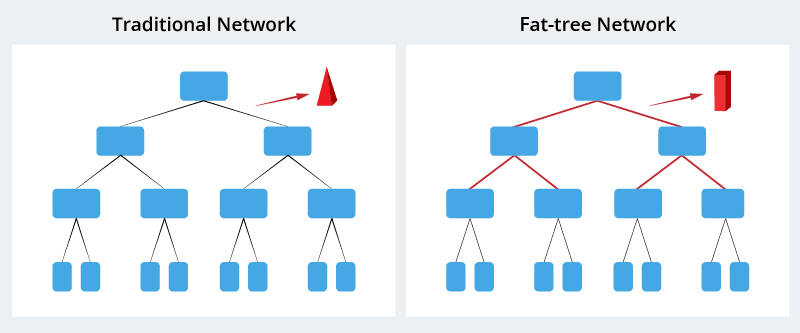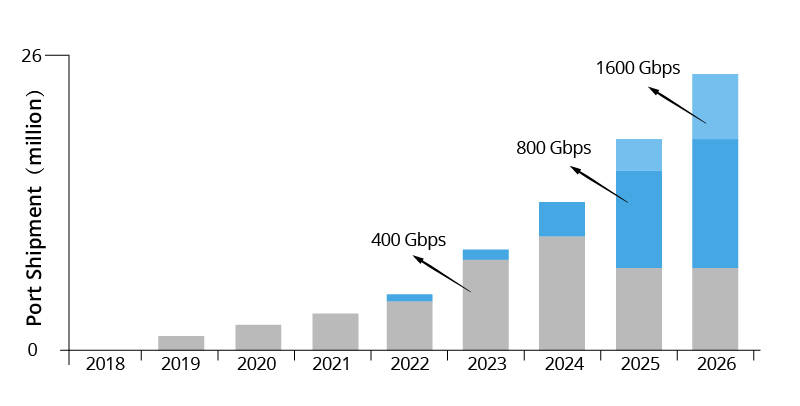Fiber Optic Tech
AI Data Center Promotes the Development of 400G/800G Optical Transceiver Modules
With the continuous development of AI technology and related applications, the importance of large models, big data and AI computing capabilities in the development of AI has become increasingly prominent. Large models and data sets form the software foundation for AI research, and AI computing power is the key infrastructure. In this article, we explore the impact of AI developments on data center network architecture.
Fat-Tree data center network architecture
With the widespread application of AI large model training in various industries, traditional networks cannot meet the bandwidth and latency requirements of large model cluster training. Distributed training of large models requires communication between GPUs, and its traffic pattern is different from traditional cloud computing, which increases the east-west traffic of AI/ML data centers. Short-term and high-volume AI data lead to network latency and reduced training performance in traditional network architectures. Therefore, in order to meet the needs of short-term and high-volume data processing, the emergence of Fat-Tree network is inevitable.
In a traditional tree network topology, bandwidth is aggregated layer by layer, and the network bandwidth at the bottom of the tree is much smaller than the total bandwidth of all leaf nodes. In comparison, a Fat-Tree looks like a real tree, with thicker branches near the root. Therefore, network bandwidth gradually increases from leaves to roots, improving network efficiency and accelerating the training process. This is the basic premise of the Fat-Tree architecture, which enables non-blocking networks.

Data Center Network Speed Upgrade and Evolution
As the complexity of data center applications continues to increase, so does the need for network speed. From 1G, 10G and 25G in the past to the widely used 100G today, the speed of data center network upgrades and evolution is accelerating. However, in the face of large-scale artificial intelligence working capacity, 400G and 800G transmission rates have become the next key process in the evolution of data center networks.

Reasons For the Growing Demand for 400G/800G Optical Transceiver Modules
Training and inference of AI algorithms require large data sets, so data centers must be able to efficiently handle the transmission of large amounts of data. The emergence of 800G optical modules provides greater bandwidth and helps solve this problem. The upgraded data center network architecture usually includes two layers, extending from switches to servers, with 400G as the bottom layer. Therefore, upgrading to 800G will also drive demand for 400G.
In some AI application scenarios, the need for real-time data processing is crucial. For example, in autonomous driving systems, massive data generated by sensors need to be transmitted and processed quickly, and optimizing system latency becomes a key factor to ensure timely response. The introduction of high-speed optical modules can quickly meet these real-time needs by reducing the latency of data transmission and processing, thereby improving the system's responsiveness.
Modern AI data centers often need to handle multiple tasks simultaneously, including activities such as image recognition and natural language processing. The use of high-speed 800G/400G optical modules can enhance support for this multi-tasking work"".
The Prospects 400G/800G Optical Module Market
At present, the demand for 400G and 800G optical modules has not yet seen significant growth, but it is expected to increase significantly in 2024, driven by the growth in AI computing demand. According to forecast, demand for 400G optical modules will increase in 2024. The growing demand for high-speed data transmission driven by AI, big data and cloud computing is expected to accelerate the growth of the 800G optical module market. This trend highlights the bright future of the 800G/400G optical module market, and its applications will gradually increase in response to the changing needs of advanced computing applications.

In the field of optical chips, 800G optical modules use a variety of optical chip technologies, including DML, EML, VCSEL, and SiPh (silicon photonics). For 100G optical modules, VCSEL and DFB are the mainstream choices for 25Gbaud optical chips; while among traditional 400G optical modules, EML has become the preferred solution for 56Gbaud optical chips.
When faced with higher requirements for 800G optical modules, multi-mode transmission VCSELs can no longer meet bandwidth requirements. Although there are corresponding solutions for 112Gbaud EML or DFB chips, their high cost limits their practical application. Therefore, silicon photonics technology, with its unique advantages, is generally regarded by the industry as one of the most promising chip solutions.
In addition, with the advent of the 800G era, silicon photonics technology will play a pivotal role and lead innovation in the chip and packaging fields.



















